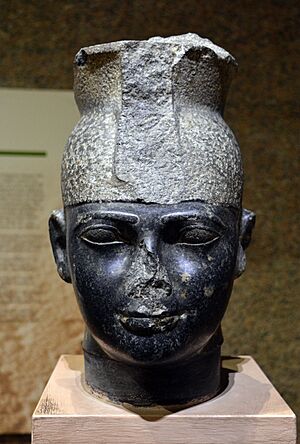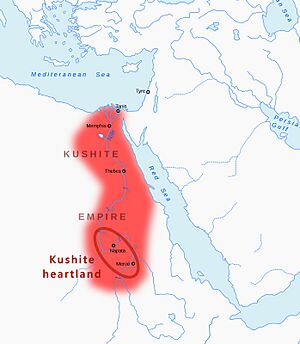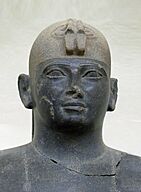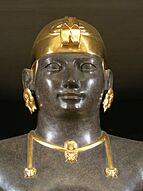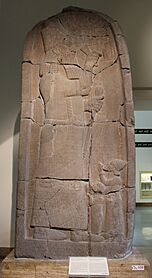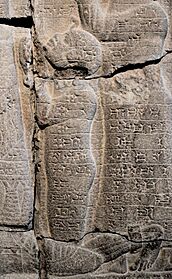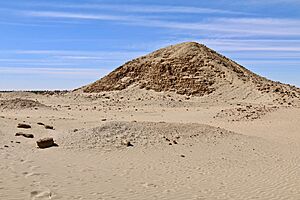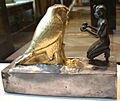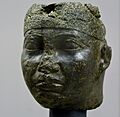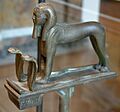Taharqa facts for kids
Quick facts for kids Taharqa |
|
|---|---|

Statue of Taharqa. His name appears on the center of his belt: 𓇿𓉔𓃭𓈎 (tꜣ-h-rw-q, "Taharqa"). The statue is 2.7 meters tall. Taharqa has a striding pose, the arms held tight, and holds the mekes staff. He wears a shendyt or pleated kilt and on his head is a double-uraeus skullcap, possibly signifying his rule over Nubia and Egypt. (Louvre Museum, color reconstruction of the jewelry through pigment analysis).
|
|
| Pharaoh | |
| Reign | 690–664 BC (25th dynasty) |
| Predecessor | Shabaka |
| Successor | Tantamani |
| Consort | Great Queen Takahatenamun, Atakhebasken, Naparaye, Tabekenamun |
| Children | Amenirdis II, Ushankhuru, Nesishutefnut |
| Father | Piye |
| Mother | Abar |
| Died | 664 BC |
Taharqa, also known as Taharka or Taharqo, was an important pharaoh of ancient Egypt. He was part of the Twenty-fifth Dynasty of Egypt, a time when kings from the land of Kush (modern-day Sudan) ruled Egypt. Taharqa was also the king of Kush from 690 to 664 BC. He was one of the "Black Pharaohs" who led Egypt for almost a century.
Contents
Becoming King
Taharqa was likely the son of Piye, a powerful Nubian king who first conquered Egypt. The family connections of this dynasty can be a bit tricky to understand. Taharqa was also the cousin of Shebitku, who was a previous ruler. The successful actions of kings like Piye and Shabaka helped set the stage for Taharqa's strong rule.
Taharqa became king in 690 BC and ruled until 664 BC. We know these dates from ancient records, like a special stone tablet found at the Serapeum. This tablet tells us about an Apis bull (a sacred animal) that was born in Taharqa's 26th year as king. This bull then died in the 20th year of a later king, Psamtik I, after living for 21 years. This information helps historians figure out the exact length of Taharqa's reign.
Taharqa said that he became king in Memphis after his predecessor passed away. He also mentioned that King Shebitku brought him to Egypt when he was young. Taharqa stated that Shebitku liked him more than his own brothers and children. This helped Taharqa gain the support of important people and become king.
Taharqa's Reign
Even though Taharqa's time as king involved many fights with the Assyrians, it was also a time of great growth and rebirth for Egypt and Kush. The empire became very strong under Taharqa. This was partly because the Nile River had a very big flood, which meant lots of crops. Also, the government was well-organized, which helped the country thrive.
Taharqa's writings show that he gave a lot of gold to the temple of Amun at Kawa. The Nile Valley empire was as large as it had been since the New Kingdom period. Taharqa and the 25th dynasty brought back many old Egyptian traditions in art, religion, and building. During his rule, the cultures of Egypt and Kush blended together so much that they stayed connected even after the Assyrians took over.
Taharqa worked to fix old temples and build new ones. His additions to the Temple at Karnak were very impressive. He also built new temples at Kawa and Jebel Barkal. Taharqa continued the 25th dynasty's plan to make Jebel Barkal a huge area of temples, especially around the great temple of Amun. Many of his other buildings helped create "Temple Towns." These towns were local centers for government, making goods, and sharing resources.
It was during the 25th dynasty that many pyramids were built in the Nile Valley, especially in modern Sudan. This was the first time so many pyramids were built since the Middle Kingdom. Taharqa built the largest pyramid in the Nubian region at Nuri. It was about 52 meters square at its base. He was buried there with over 1070 small statues called shabtis, made of different materials.
Wars with Assyria
Taharqa started making friends with leaders in Phoenicia and Philistia. These areas wanted to be more independent from Assyria. Taharqa's army had successful military campaigns. Ancient records show lists of places he conquered, like parts of Asia, Libyan areas, and Phoenicia. Some historians believe Taharqa's army was strong because he made his soldiers train daily in long-distance running. Also, Assyria was busy with problems in Babylon and Elam. Taharqa also built military bases at forts like Semna and Buhen.
War with the Assyrian Empire was unavoidable because Assyria wanted to expand its control. In 701 BC, Taharqa's Kushite army helped the Kingdom of Judah and King Hezekiah. They were able to defend Jerusalem against the Assyrian King Sennacherib. There are different ideas about why the Assyrians failed to take Jerusalem. Some say Taharqa's army helped, others mention disease or divine help.
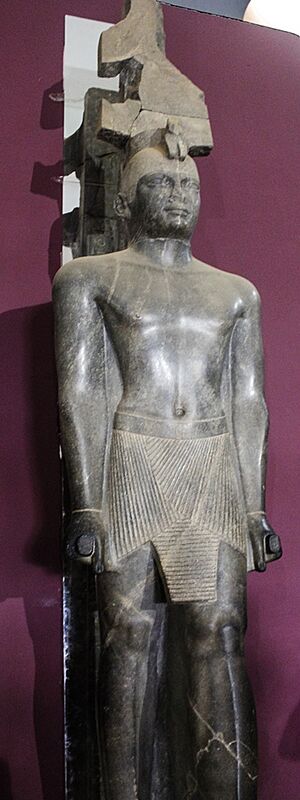
In 679 BC, Sennacherib's successor, King Esarhaddon, attacked areas loyal to Egypt. After destroying Sidon and forcing Tyre to pay taxes in 677-676 BC, Esarhaddon invaded Egypt in 674 BC. Taharqa and his army defeated the Assyrians in this battle. This invasion, which few Assyrian records mention, was a big defeat for Assyria. In 672 BC, Taharqa brought more soldiers from Kush.
However, Taharqa was defeated in Egypt in 671 BC. Esarhaddon conquered Northern Egypt, captured Memphis, and made Egypt pay taxes. Taharqa escaped to the south, but Esarhaddon captured his family, including his son and royal wives. They were sent to Assyria as prisoners. Ancient tablets mention that many horses and gold items were taken to Assyria.
In 669 BC, Taharqa took back Memphis and other areas. He also started making plans with the king of Tyre again. Taharqa stirred up many revolts in Lower Egypt. Esarhaddon led his army to Egypt again, but he died in 668 BC. Command then went to Ashurbanipal. Ashurbanipal and the Assyrians defeated Taharqa again and went as far south as Thebes. Ashurbanipal appointed Necho I as his ruler in Egypt. Necho's son, Psamtik I, was even educated in the Assyrian capital of Nineveh.
The remains of three huge statues of Taharqa were found at the entrance of the palace in Nineveh. These statues were probably taken as war trophies by Esarhaddon. He also brought back royal prisoners and many valuable items from Egypt.
Death and Burial
Taharqa died in the city of Thebes in 664 BC. His chosen successor was Tantamani, who was a son of Shabaka. Tantamani invaded Lower Egypt, hoping to get back control for his family. This led to more conflict with Ashurbanipal and the Sack of Thebes by the Assyrians in 663 BCE. After Tantamani, a son of Taharqa named Atlanersa became king.
Taharqa's Pyramid at Nuri
Taharqa chose a new place called Nuri in North Sudan to build his pyramid. This was different from the usual burial site of El-Kurru. His pyramid was the first and largest at Nuri. About twenty later kings were also buried there after him.
How Taharqa Was Seen
The ancient Greek historian Strabo wrote about Taharqa, calling him "Tearco the Aethiopian." Strabo listed Taharqa among other famous conquerors like Cyrus the Great. He said that these rulers went on "expeditions to lands far remote." Strabo even mentioned that Taharqa went as far as Europe and the Pillars of Hercules in Spain.
The two snakes on Taharqa's crown showed that he was king of both Egypt and Nubia.
Taharqa's Monuments
Taharqa left behind many monuments across Egypt and Nubia. In places like Memphis, Thebes, and Napata, he rebuilt or fixed the Temple of Amon.
Taharqa's Buildings in Karnak
Taharqa is well-known for his many buildings and additions at Karnak.
Taharqa's Shrine in Kawa
A small temple built by Taharqa was once located at Kawa in Nubia (modern Sudan). Today, you can find parts of it in the Ashmolean Museum.
-
The Shrine of Taharqa, Ashmolean Museum
-
Taharqa cartouche on the Shrine
-
Taharqa and the gods of Gematen (the Temple of Kawa). He makes an offering to the ram-headed god Amun-Re. Kawa shrine.
-
Taharqa (left) embracing Horus (Re-Horakhty) on the Kawa shrine
Taharqa in Jebel Barkal
Taharqa is shown in various carvings and reliefs at Jebel Barkal, especially in the Temple of Mut.
-
Lion-headed God Appademak with Pharaoh Taharqa (right) in the Jebel Barkal Temple of Mut
-
Taharqa, followed by the sistrum shaking queen Takahatenamun in the Jebel Barkal Temple of Mut
-
Taharqa making dedications to Egyptian Gods, in the Temple of Mut, Jebel Barkal, Sudan. His name appears in the second cartouche: 𓇿𓉔𓃭𓈎 (tꜣ-h-rw-k, "Taharqa").
Museum Artifacts
-
Taharqa under a sphinx, British Museum
-
Granite sphinx of Taharqa from Kawa in Sudan
Images for kids
-
Stele remembering the death of an Apis bull that was placed in "Year 26 of Taharqa". Found in the Serapeum of Saqqara, Saqqara. Louvre Museum.
-
Stele from the Great Temple of Tanis, made in "Year 6 of Taharqa".
See also
- List of monarchs of Kush
- List of biblical figures identified in extra-biblical sources
- Victory stele of Esarhaddon
- Statues of Amun in the form of a ram protecting King Taharqa
- Sphinx of Taharqo


